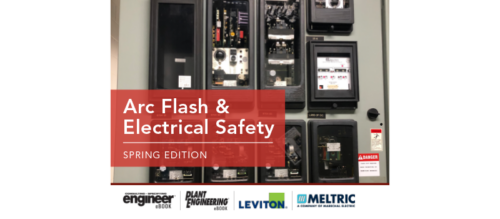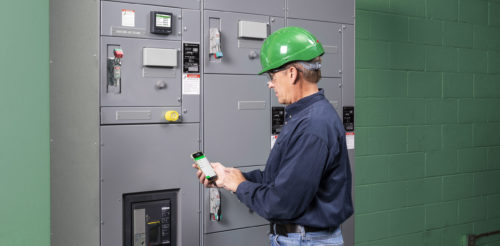NFPA 70E-2004: What you need to know
In the industrial workplace today, how does a company provide electrical safety for workers that is practical, comprehensive, and complies with OSHA regulations? NFPA 70E-2000, Standard for Electrical Safety Requirements for Employee Workplaces is the ANSI consensus standard that addresses the electrical safety requirements for the safeguarding of workers.
Key Concepts
NFPA 70E has been updated to increase the technical accuracy of the document, and improve its user friendliness.
The 2004 edition of 70E defines terms such as flash protection boundary, incident energy, and flash hazard analysis.
Energized electrical work permit requirements are addressed.
The appendices have been renamed and moved to the back of the document.
Sections: The new look Main topics reorganized Definitions Changes in safety-related work practices Annexes Conclusion More Info:
In the industrial workplace today, how does a company provide electrical safety for workers that is practical, comprehensive, and complies with OSHA regulations? NFPA 70E-2000, Standard for Electrical Safety Requirements for Employee Workplaces is the ANSI consensus standard that addresses the electrical safety requirements for the safeguarding of workers. It is used as the practical application of two OSHA regulations — 29 CFR 1910 Subpart S and 29 CFR 1926 Subpart K — which provide the framework for employers to address electrical safety. But in many instances, it does not identify or provide a protective scheme for the worker.
In 1976, the NFPA 70E committee was formed at OSHA’s request to develop a standard that would serve its needs in providing electrical safety in the workplace. NFPA 70E has been developed and enhanced over the last quarter-century to provide a consensus-based practical application and solution to OSHA electrical safety regulations.
The technical committee is comprised of a cross section of interested parties including users, labor, manufacturers, enforcers, installers/maintainers, and special experts. NFPA regulations require that the technical committee be balanced so that a single interest is not represented by more than 1/3 of the committee. The balance of the committee and the specific expertise of its members are the two key factors that bring broad industry acceptance of the document and incorporation of proven concepts and technology.
The new look
The 2004 edition of 70E has a new title, cover, and format. The new title, NFPA 70E-2004, Standard for Electrical Safety in the Workplace , exemplifies the increasing acceptance and effectiveness of the document in providing comprehensive electrical safety for workers (Fig. 1). The technical committee had a two-fold mission during this revision cycle — increase the technical accuracy of the document, and improve its user friendliness. The user-friendliness issues were critical in providing valuable technical resources to a wide range of users.
The 2000 edition consisted of four parts, with chapters in each part — a format that created redundant numbering. The Standards Council approved the document’s new reformat according to the NEC Style Manual , which provided three benefits. First, it increased user familiarity with the document because many of the 70E users were also familiar with the National Electrical Code . Second, it created a unique designation for every topic in the document. Finally, it applied NEC rules such as moving explanatory, unenforceable material to annexes and fine-print notes. A new cross-reference index, Annex M, compares the 2000 and 2004 editions. This index is also available on the NFPA 70E website ( nfpa.org ).
Main topics reorganized
The committee members agreed to move the existing “Part 2, Safety-Related Work Practices” to Chapter 1 because the main focus of the document is to provide safety-related work practices for workers, and most questions about the document focus on safety-related work practices. The existing “Part 3, Safety-Related Maintenance Practices,” was moved from Part 3 to the new Chapter 2. The existing “Part 4, Special Equipment,” was relocated from Part 4 to Chapter 3. The existing “Part 1, Safety-Related Installation Practices” was relocated to Chapter 4. The committee agreed to retain the NEC requirements in the body of the standard to provide an essential basis for OSHA to enforce installation requirements that are important for worker safety.
Metrification was also added to the document to comply with the NFPA Manual of Style . This addition will increase the usability of the document in the international arena.
Definitions
Definitions were moved to Article 100, and several were modified to comply with the NEC Style Manual . The committee modified the definitions of limited approach boundary, restricted approach boundary, and prohibited approach boundary, and in doing so has provided the proper perspective and enhanced understanding of these shock protection boundaries. The necessary requirements were incorporated into the body of the document. The definitions of energized and live parts were updated to correlate with the 2002 NEC . The terms flash protection boundary, incident energy, flame resistant (FR), arc rating ,and flash hazard analysis were defined to enhance the usability and understanding of the document.
Changes in safety-related work practices
General industry vs. construction requirements
Early in the revision cycle process a task group was appointed by the chairman to determine whether the document should have a separate chapter to address the work requirements of the construction industry. This chapter could establish the requirements based on OSHA regulations regarding 29 CFR 1910 for General Industry and 29 CFR 1926 for Construction . The committee determined that a special section for construction is not necessary and that rules would apply to all workers, regardless of occupation or work category, because electrical hazards for the worker are the same for general industry and construction. For example, if a worker is working on an energized 400-A, 600-V disconnect switch, he or she is exposed to the same hazard regardless of whether the setting is in general industry or in construction.
Reorganization of safety-related work practices
The safety-related work practice requirements have evolved and been enhanced over the six previous editions of 70E. Because these requirements were added over a long period of time, they did not, in some instances, follow a concise path for the user. The task group recommended that the chapter be reorganized to emphasize the strategic concepts embraced by the technical committee. The strategic steps included a four-step process in the sequence of establishing an electrically safe work condition, followed by training, planning the work, and finally, if it becomes infeasible to perform the work deenergized, provide a protective scheme, including protective equipment, that would provide adequate safety for the worker.
The requirements for safety-related work practices were also integrated into three articles. The new articles of this chapter are general, establishing an electrically safe work condition, and working on or near live parts. This format provides enhanced usability and understanding of the requirements to protect workers
Multiple employer relationship
In Article 110, the multiple-employer relationship policy was added to harmonize with OSHA’s multiple-employer citation policy. The committee solidified the its position that general industry and construction are interrelated and that the communication among all parties is critical for a safe work environment.
The new wording addressed three distinct concepts. First, more than one employer might be responsible for worker safety. Second, information regarding procedures, hazards, and protective clothing must be shared among all parties, and third, a meeting, with documentation, is required to ensure that these issues have been addressed.
An electrically safe work condition
The primary protective strategy is to establish an electrically safe work condition. This aligns with the requirements of OSHA 29 CFR 1910.333(a)(1) , which requires that live parts be deenergized unless the employer can demonstrate that the deenergizing introduces additional or increased hazards.
The strategy is simpler once the electrically safe work condition has been established and no electrical hazard exists. The strategy ensures that the energy has been completely removed and the worker is not at risk (Fig. 2).
Qualified persons know that the process of establishing an electrically safe work condition can be hazardous and requires the same considerations as working on live parts. Once the electrically safe work condition exists, all electrical hazards have been removed and cannot reappear. No work should ever be performed on or near live parts until this primary protective strategy has been considered.
Energized electrical work permit The committee approved an energized electrical work permit requirement when working on or near live parts. This permit provides the written documentation to prove that it is infeasible to work on the equipment or circuits deenergized as required by the OSHA regulations. Once the infeasibility of deenergizing has been established, the energized work permit is intended to verify that all parties are aware of the hazards and that the proper training, procedures, and techniques are in place and are being used. It also provides accountability for work policies and procedures.
The permit requires written authorization via an energized electrical work permit for work on or near a circuit that is energized at 50 V or greater. The permit must include, at a minimum, the following requirements:
Description and location of the circuit and equipment to be worked on
Justification for why the work must be performed in an energized condition
Description of the safe work practices to be employed
Results of the shock hazard analysis
Determination of shock protection boundaries
Results of the flash hazard analysis
The flash protection boundary
Personal protective equipment (PPE) determined necessary to safely perform the assigned task
Means employed to restrict the access of unqualified persons from the work area
Evidence of completion of a job briefing, including a discussion of any job-specific hazards
Signatures on an energized work permit (by authorizing or responsible management, safety officer, or owner).
Testing, troubleshooting, and measuring voltage are permitted to be performed without an energized electrical work permit, provided that appropriate safe work practices and PPE are provided and used in accordance with Chapter 1 of NFPA 70E-2004 .
Selection of personal protective equipment
The standards for protective equipment were updated to align with the latest technology. These standards are essential to analyze whether the PPE provided for the worker is suitable for the task (Fig. 3). OSHA compliance officers use these standards as tools to determine if the PPE selection is proper.
Two new standards have been added to this list. ASTM F1891-02a, Standard Specification for Arc and Flame Resistant Rainwear was added to help companies analyze which rainwear would be appropriate for hazardous tasks. ASTM F2178-02, Standard Test Method for Determining the Arc Rating of Face Protective Devices was added to comply with new equipment technology. This standard ensures that the face shield has met acceptable testing for a thermal rating that is consistent with the units used for PPE garments.
Risk table
The hazard risk classification table was retained with the same requirements as the 2000 edition. This table was the subject of numerous proposals and comments. The committee discussed it at length. Dialogue was accompanied by lively debate. Because research and technology are still emerging, the technical committee did not reach consensus to modify this table. Instead, the table in 70E-2000, exhibiting a proven track record with thousands of users, will be the foundation for future enhancements based on scientific discovery and proven technology.
The “Protective Clothing and Personal Protective Equipment Matrix” was modified to align with proven technology. The most significant change is the addition of the arc rated face shield in Hazard Risk Category 2. This equipment provides face protection for exposures up to 8 cal/cm2, while allowing enhanced worker visibility in performing a task.
The protective clothing characteristics table was modified on the basis of technological changes. The clothing description was modified because of advancement in FR clothing. The weight of FR fabric was deleted, making the calorie rating of the clothing the determining factor. The calorie requirements for Category 1 clothing were changed to 4 cal/cm2. Metrification was added to comply with the NEC Style Manual .
The clothing material characteristics section was modified to clarify melting and flammability characteristics for clothing. These modifications included the integration of ASTM standards as a method of determining the suitability of clothing.
Safety-related installation requirements
The “Safety-Related Installation Requirements” have been updated to match the 2002 NEC . This section has been relocated to Chapter 4. The committee agreed that these requirements are an important tool for OSHA compliance enforcement and should be retained in the body of the document for that purpose.
Annexes
All of the appendices in the 2000 Edition of 70E were located within their respective sections. In the 2004 edition, the appendices have been renamed as Annexes and have been moved to the back of the document.
“Annex D, Sample Calculations of Flash Protection Boundary” received modifications and additions. Some of the sample calculations were modified for accuracy. New calculation methods and equations have been added based on IEEE 1584, Guide for Performing Arc-Flash Hazard Calculations methods .
“Annex I, Job Briefing and Planning Checklist” has been added to provide workers with a template for developing a form for their companies. Historical data from OSHA have shown that communications among all affected parties is critical in preventing electrical incidents and injuries. This sample checklist provides guidance to conduct a comprehensive job briefing, and covers a wide spectrum of issues for consideration when conducting a job briefing. It includes identifying the hazards and their parameters in relation to the worker, checking facility information and procedures, determining which resources would be conducive to incorporate into the work plan, and preparing for an emergency.
“Annex J, Energized Electrical Work Permit” is a sample that could be used to comply with the associated requirements in Article 130. This sample is divided into three parts: Part 1 to be completed by the requester, Part 2 to be completed by the electrically qualified person(s) performing the work, and Part 3 to be approved by management.
“Annex K, General Categories of Electrical Hazards” provides an explanation of the three categories of electrical hazards. This annex explains electric shock, arc flash, and arc blast in user-friendly text.
Conclusion
NFPA 70E is updated on a 3-yr cycle in compliance with ANSI requirements. In the process of enhancing the quality of future editions of NFPA 70E , the chairman has made two initiatives. The first initiative is a request that the NFPA Research Foundation establish a project to investigate the effects of electrical arc blast. The information obtained from this project will assist the committee in reviewing the existing requirements in the document and base any future modifications on solid scientific data. The second initiative is to appoint a Future Direction Task Group to identify electrical safety issues that are not now addressed by the standard, identify new protective strategies for incorporation, and provide guidance about how to improve the effectiveness of the standard.
Like the National Electrical Code , NFPA 70E is a consensus standard, which means that anyone affected by it can participate in the review and update process. Technical committee members routinely propose changes, but the general public is also encouraged to do the same, as well as to comment on any of the proposed changes before the committee formally votes on them. This open consensus process is the key to improving the document and ensuring that industry has an effective, up-to-date, electrical safety standard for the protection of workers.
More Info:
For more information about arc flash hazards and other electrical safety issues, go to plantengineering.com or nfpa.org. NFPA 70E-2004, Standard for Electrical Safety in the Workplace can be ordered from NFPA at 800-344-3555 or nfpa.org . Article edited by Jack Smith, Senior Editor, 630-288-8783, jsmith@reedbusiness.com .
Do you have experience and expertise with the topics mentioned in this content? You should consider contributing to our CFE Media editorial team and getting the recognition you and your company deserve. Click here to start this process.




